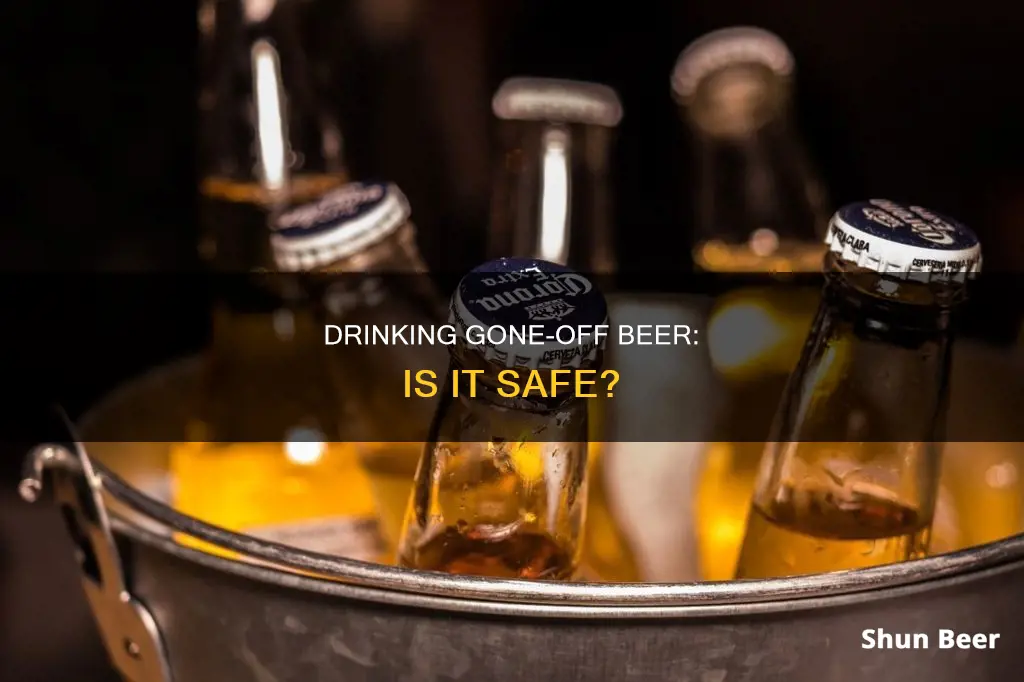
Beer is produced with expiry dates, but these are more of a guideline on quality than safety. While it's unlikely to make you sick, drinking beer past its best-before date will probably result in an unpleasant taste and aroma experience.
| Characteristics | Values |
|---|---|
| Safety of drinking expired beer | Drinking expired beer is generally safe, but it may taste unpleasant. |
| Beer storage | Beer should be stored in a cool, dark place, away from direct sunlight and sources of heat. |
| Beer shelf life | Beer can last 5-9 months beyond the expiration date listed on the label at room temperature. In a refrigerator, unopened beer can last up to 2-3 years, while opened beer has a shelf life of about a day. |
| Beer types | Stronger beers, such as stouts and porters, tend to have a longer shelf life than lighter beers like lagers and pilsners. Hoppy beers, like IPAs, are best consumed fresh. |
What You'll Learn
- Beer won't make you sick, even if it's past its best-before date
- Beer can be stored in a refrigerator to extend its shelf life
- Beer should be stored upright to minimise oxidation
- Beer stored in clear or green bottles is more susceptible to degradation from light exposure
- Beer with higher alcohol content tends to last longer

Beer won't make you sick, even if it's past its best-before date
That being said, the taste of beer changes over time, and what was once a refreshing treat could become a real stinker. Oxidation causes the beer to stale, producing tones of sherry, paper, and cardboard. Hop aromas are muted, and hop beta acids oxidize to produce an unrefined bitterness. Other forms of staling can lead to a soapy taste.
Generally, the higher the alcohol content of the beer, the less you need to worry about its use-by date. Some beers, like porters and stouts, can even improve with age. However, IPAs are best enjoyed fresh, as they gradually lose their flavour and aroma over time.
How can you tell if a beer has gone bad? Well, it should be fairly obvious from the bad aroma. If it's missing the usual 'pssst' sound and foaming when you open it, it's probably turned. You could also look at the bottom of the bottle for excessive sediment, which could contribute to a poor taste.
Mono and Beer: Is It Safe to Drink?
You may want to see also

Beer can be stored in a refrigerator to extend its shelf life
Beer is susceptible to spoilage due to various factors, such as exposure to sunlight, oxygen, and bacteria. However, storing beer in a refrigerator can effectively extend its shelf life.
The temperature at which beer is stored plays a crucial role in maintaining its quality. Beer stored at room temperature typically lasts for 5 to 9 months beyond its expiration date. On the other hand, refrigeration can extend this period significantly. In a refrigerator, unopened beer can last for up to 2 to 3 additional years, while opened beer has a shelf life of about a day.
The optimal temperature range for packaged beer is between 45 and 55 degrees Fahrenheit. Storing beer within this temperature range helps slow down the ageing process and prevents spoilage. Additionally, it is recommended to keep beer in a cool, dark place, as UV rays from sunlight can cause a chemical reaction, resulting in an unpleasant skunky odour and taste.
Another factor to consider is the container in which the beer is stored. Canned beer generally has a longer shelf life than bottled beer because cans block out light, preventing oxidation and preserving the beer's quality for a more extended period.
By storing beer in a refrigerator and considering factors such as temperature, light exposure, and container type, individuals can effectively extend the shelf life of their favourite brews.
Drinking Beer at Disney World: What's Allowed?
You may want to see also

Beer should be stored upright to minimise oxidation
Oxidation is one of the main causes of beer degradation, along with light and heat. It occurs when oxygen interacts with the compounds from malt, yeast, and hops, creating an unpleasant papery or cardboard-like flavour. This process is accelerated by heat and motion, so it's important to keep beer cool and limit agitation.
To minimise oxidation, it is recommended to store beer bottles upright. This is because the slim neck of the bottle means less surface area of the beer is exposed to the oxygen in the headspace when compared to lying the bottle on its side. Additionally, storing beer upright prevents the creation of a yeast ring (or watermark) inside the bottle, which can affect the flavour of the beer.
Cans are also effective at minimising oxidation, as they have a tighter seal than bottles, preventing gases from escaping or entering. They also block out light strike, which can cause skunked beer. However, the larger surface area of a can when upright may potentially lead to slightly faster oxidation compared to bottles.
To further reduce oxidation, beer should be stored in a cool, dark place, preferably in the refrigerator. If refrigeration is not possible, it is important to keep the beer in a relatively cool, dark, and dry environment, avoiding direct sunlight and temperature fluctuations.
By storing beer upright and maintaining optimal storage conditions, you can help prolong the shelf life of your beer and preserve its flavour and quality.
Beer After a CT Scan: What You Need to Know
You may want to see also

Beer stored in clear or green bottles is more susceptible to degradation from light exposure
Beer is susceptible to degradation from various factors, including oxygen, heat, and light. While the fermentation process, low pH level, and alcohol content of beer make it fairly resistant to bacterial build-up, it can still go "'bad'" and develop an unpleasant taste or aroma over time.
One of the main causes of beer degradation is exposure to light, specifically UV light, which can cause a chemical reaction in the hops, resulting in an unpleasant skunky taste and aroma. This is often referred to as "lightstruck" beer.
Beer bottles come in different colours, such as clear, green, and brown. Clear and green bottles offer little to no protection against UV light, as they allow UV wavelengths to pass through relatively easily. This can lead to the beer inside becoming lightstruck and developing the characteristic skunky flavour.
On the other hand, brown bottles are effective at filtering out both visible and ultraviolet light, thus providing better protection against light-induced degradation. This is why brown bottles are often recommended for storing beer, especially if it is to be exposed to light during storage or transportation.
However, it is important to note that the susceptibility of beer to light degradation also depends on the type of beer. Beers with little or no hops content are less susceptible to light damage, which is why clear and green bottles are widely accepted for those beers. Additionally, some breweries embrace the light-struck flavour and consider it part of their beer's profile.
Expired Beer: Is It Safe to Drink?
You may want to see also

Beer with higher alcohol content tends to last longer
Beer is made from raw materials, and as with any product made from plants, it will eventually go bad. The standard ingredients in beer are malt (made from dried barley), water, and yeast. Hops are added towards the end of the brewing process. Hops impart bitter, floral, or citrus notes and aromas, and they also play a big part in stabilising and preserving the beer.
The alcohol content of beer varies depending on the type and brewing process. Light beers typically have between 4% and 5% ABV, while regular beers have between 5% and 6%. Craft beers usually range from 6% to 10% ABV, and stronger styles, such as double IPAs and imperial stouts, can reach 15% ABV or more.
Some beers, like wine and whiskey, can improve with age. Richer and higher ABV varieties of beer, such as porters and stouts, can get better with age, especially if they are kept in cool, dark storage conditions like a basement or cellar. On the other hand, IPAs gradually lose their flavour and aroma over time and are best consumed fresh.
It's important to note that drinking expired beer usually won't cause any harm, but the taste will change significantly. Expired beer may taste stale or bad, and it may no longer have carbonation. Additionally, the way beer is stored can impact its longevity. Beer should be stored upright in a cool, dark place with a constant temperature, and refrigeration can extend its shelf life.
Beer as Petrol: Can You Really Run on Hops?
You may want to see also
Frequently asked questions
Drinking beer that has gone past its best-before date is generally safe, as the alcohol content and the presence of hops prevent any harmful bacterial growth. However, the taste and quality of the beer will deteriorate over time.
Beer can last 6-24 months beyond its best-before date if refrigerated, and up to 9 months if unrefrigerated. However, the taste and quality will gradually decline, and it is recommended to consume beer as fresh as possible.
A bad beer will usually have an obvious off-putting aroma, and it may be flat with no fizz when opened. Excessive sediment at the bottom of the bottle can also indicate that the beer has gone bad and may contribute to a poor taste.
Yes, stronger beers with higher alcohol content, such as stouts and porters, tend to have longer shelf lives than lighter beers like lagers and pilsners. Hoppy beers like IPAs are best consumed fresh, as the delicate hop characteristics fade over time.
Beer should be stored in a cool, dark place, preferably in a refrigerator. If stored at room temperature, keep it in a cool, dark area away from direct sunlight. Beer should also be stored upright to minimise oxidation.







